- Clone
- CG4 (See other available formats)
- Regulatory Status
- RUO
- Other Names
- TM7XN1
- Isotype
- Mouse IgG1, κ
- Ave. Rating
- Submit a Review
- Product Citations
- publications
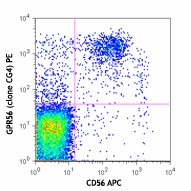
-

Human peripheral blood lymphocytes were stained with CD56 APC and GPR56 (clone CG4) PE (top) or mouse IgG1, κ PE isotype control (bottom). -

| Cat # | Size | Price | Quantity Check Availability | Save | ||
|---|---|---|---|---|---|---|
| 358203 | 25 tests | £92 | ||||
| 358204 | 100 tests | £215 | ||||
GPR56, also known as TM7XN1, is an orphan G-protein-coupled receptor (GPCR) containing seven transmembrane domains and a mucin-like domain in the N-terminal region. The total length of the human GPR56 gene is approximately 15 kb, and it consists of 13 exons and encodes 693 amino acids. GPR56 is expressed in a wide range of tissues, such as brain, thyroid gland, and heart. Mutations in human GPR56 gene were found to cause a specific brain malformation called bilateral frontoparietal polymicrogyria. Recently, GPR56 was found specifically expressed on cytotoxic NK and T lymphocytes, including CD8+, CD4+, and γδ T cells, which might affect the migratory properties of these cells. GPR56 was also found significantly downregulated in some cancer cells, suggesting that it may play a role in growth suppression and cancer metastasis.
Product DetailsProduct Details
- Verified Reactivity
- Human, Mouse
- Antibody Type
- Monoclonal
- Host Species
- Mouse
- Immunogen
- Human GPR56-mouse Fc fusion protein
- Formulation
- Phosphate-buffered solution, pH 7.2, containing 0.09% sodium azide and BSA (origin USA)
- Preparation
- The antibody was purified by affinity chromatography and conjugated with PE under optimal conditions.
- Concentration
- Lot-specific (to obtain lot-specific concentration and expiration, please enter the lot number in our Certificate of Analysis online tool.)
- Storage & Handling
- The antibody solution should be stored undiluted between 2°C and 8°C, and protected from prolonged exposure to light. Do not freeze.
- Application
-
FC - Quality tested
- Recommended Usage
-
Each lot of this antibody is quality control tested by immunofluorescent staining with flow cytometric analysis. For flow cytometric staining, the suggested use of this reagent is 5 µl per million cells in 100 µl staining volume or 5 µl per 100 µl of whole blood.
- Excitation Laser
-
Blue Laser (488 nm)
Green Laser (532 nm)/Yellow-Green Laser (561 nm)
- Application Notes
-
Clone CG4 cross-reacts with mouse1.
-
Application References
(PubMed link indicates BioLegend citation) -
- Rao TN, et al. 2015. Stem Cell Res. 14:307. (FC) PubMed
- Product Citations
-
- RRID
-
AB_2562083 (BioLegend Cat. No. 358203)
AB_2562084 (BioLegend Cat. No. 358204)
Antigen Details
- Structure
- Contains seven transmembrane domains and a mucin-like domain in the N-terminal region
- Distribution
-
T cells, NK cells, wide range of tissues such as brain, thyroid gland, and heart
- Function
- May be involved in immune cell migration, cancer cell growth metastasis, and neuron development
- Cell Type
- NK cells, T cells
- Biology Area
- Apoptosis/Tumor Suppressors/Cell Death, Cell Adhesion, Cell Biology, Immunology
- Molecular Family
- Adhesion Molecules
- Antigen References
-
1. Peng YM, et al. 2011. J. Leukoc. Biol. 90:735.
2. Shashidhar S, et al. 2005. Oncogene 24:1673.
3. Piao X, et al. 2004. Science 303:2033.
4. Liu M, et al. 1999. Genomics 55:296. - Gene ID
- 9289 View all products for this Gene ID
- UniProt
- View information about GPR56 on UniProt.org
Related Pages & Pathways
Pages
Related FAQs
- What type of PE do you use in your conjugates?
- We use R-PE in our conjugates.
Other Formats
View All GPR56 Reagents Request Custom Conjugation| Description | Clone | Applications |
|---|---|---|
| Purified anti-human GPR56 | CG4 | FC |
| PE anti-human GPR56 | CG4 | FC |
| PE/Cyanine7 anti-human GPR56 | CG4 | FC |
| TotalSeq™-A0912 anti-human GPR56 | CG4 | PG |
| TotalSeq™-C0912 anti-human GPR56 | CG4 | PG |
| TotalSeq™-B0912 anti-human GPR56 | CG4 | PG |
| TotalSeq™-D0912 anti-human GPR56 | CG4 | PG |
Customers Also Purchased
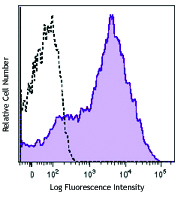
Compare Data Across All Formats
This data display is provided for general comparisons between formats.
Your actual data may vary due to variations in samples, target cells, instruments and their settings, staining conditions, and other factors.
If you need assistance with selecting the best format contact our expert technical support team.
-
Purified anti-human GPR56
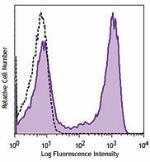
Human peripheral blood lymphocytes were stained with purifie... -
PE anti-human GPR56
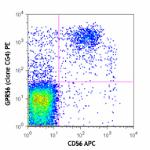
Human peripheral blood lymphocytes were stained with CD56 AP... 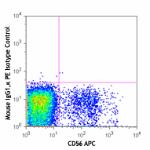
-
PE/Cyanine7 anti-human GPR56

Human peripheral blood lymphocytes were stained with CD56 AP... -
TotalSeq™-A0912 anti-human GPR56
-
TotalSeq™-C0912 anti-human GPR56
-
TotalSeq™-B0912 anti-human GPR56
-
TotalSeq™-D0912 anti-human GPR56
 Login / Register
Login / Register 









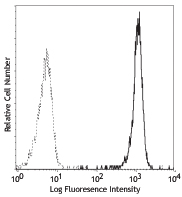
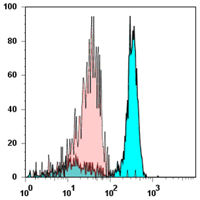




Follow Us